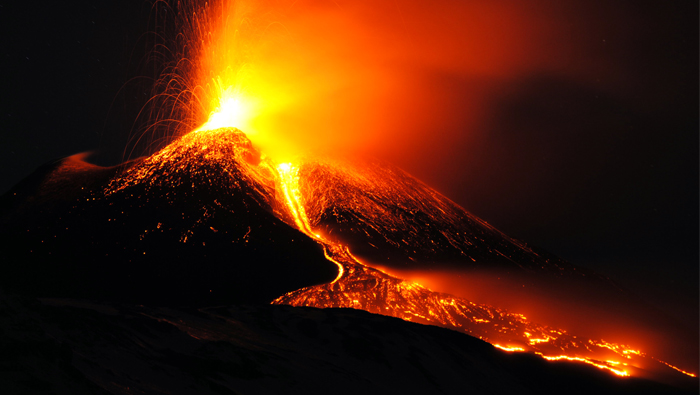
Volcanoes are ruptures in the Earth’s crust spewing hot lava, volcanic ash, and gases from the magma chamber below the surface, due to density and pressure.
Ring of Fire
Most volcanoes are found along the edges where giant land masses called tectonic plates collide. Earthquakes and volcanic eruptions sometimes occur together. About 90 per cent of all volcanoes form along the edges of the Pacific Ocean, an area that is sometimes called the Ring of Fire.
Magma
Magma is superhot, molten rock that forms in the Earth’s mantle. Volcanoes serve as a kind of vent for magma making its way to the surface.
Active Volcanoes
There are about 500 active volcanoes on Earth, which are likely to explode again. Other volcanoes are dormant and may eventually become active. A volcano which has not erupted in more than 10,000 years is considered extinct and unlikely to ever erupt.
Lava (on the rocks)
Depending on the type of rock it contains, lava may be thick or runny. Trapped gases make bubbles in the lava, and a large amount of gas may cause explosions when the lava reaches the surface.
Lava flows can reach 2,000 degrees Fahrenheit (1,250 degrees Celsius) or more. A lava flow will burn anything in its path. Volcanic rock is also varied. Pumice is brittle and dusty, while obsidian is smooth and clear, like smoked glass.
Volcano Types
Cinder cone volcanoes are the most common type of volcano. These cone-shaped volcanoes are formed when lava cools quickly and builds up around the vent, forming a crater at the summit.
Strato volcanoes erupt with great violence. They are formed from layers of lava flow, ash and blocks of unmelted stone. They are larger than cinder cones, rising up to 8,000 feet (2,438m). Mount St. Helens, in Washington state, is a strato volcano that erupted in 1980. Shield volcanoes are huge, gently sloping volcanoes, the result of very thin lava spreading out in all directions from a central vent. Eruptions are rarely explosive, and the lava resembles a liquid overflowing around the edges of a container. Mauna Loa in Hawaii, a shield volcano, is one of the world’s largest and most active volcanoes.
Hawaii’s Kilauea volcano is one of the most active on Earth. The most violent volcanic eruption ever recorded was that of Mount Tambora on Sumbawa Island, Indonesia, in 1815. It ranked a 7, or super-colossal, on the Volcanic Explosivity Index. One of the world’s most famous volcanoes is Mount Vesuvius in southern Italy. It has erupted more than 50 times over the past 2,000 years. The A.D. 79 eruption buried the city of Pompeii and was responsible for the deaths of up to 25,000 people. Another eruption in 1631 killed 3,000 people.